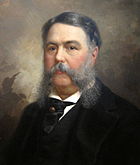Chester A. Arthur
This article relies largely or entirely on a single source. (December 2020) |
Chester A. Arthur | |
|---|---|
 Portrait by Charles Milton Bell, 1882 | |
| 21st President of the United States | |
| In office September 19, 1881 – March 4, 1885 | |
| Vice President | None |
| Preceded by | James A. Garfield |
| Succeeded by | Grover Cleveland |
| 20th Vice President of the United States | |
| In office March 4, 1881 – September 19, 1881 | |
| President | James A. Garfield |
| Preceded by | William A. Wheeler |
| Succeeded by | Thomas A. Hendricks |
| Personal details | |
| Born | October 5, 1829 Fairfield, Vermont |
| Died | November 18, 1886 (aged 57) New York City, New York |
| Nationality | American |
| Political party | Republican |
| Spouse(s) | Ellen Lewis Herndon Arthur |
Chester Alan Arthur (October 5, 1829 – November 18, 1886) was the 21st president of the United States from 1881 to 1885. Before becoming president, he was most noted as the Collector of Customs for the Port of New York, a job he got from his political friendships. Arthur was the first president of the United States to take oath of office at his own house.[1]
Arthur was a lawyer in New York City. Two of his cases were famous. One confirmed that any slave brought to New York was automatically set free. The other ended the racial segregation of streetcars in the city.
After President James A. Garfield died, vice-president Chester Arthur replaced him. The man who killed him expected the new president to pardon him. This did not happen.
During Arthur's term a major problem was that people were appointing their friends (such as himself) into high political offices instead of people who were most qualified to do the job. The problem was solved after he promoted the Pendleton Civil Service Reform Act which required people to pass tests before they could be appointed to a public job.
References
[change | change source]- ↑ "10 Interesting Facts About Chester Arthur". Republican Presidents.net. 28 February 2009. Retrieved November 4, 2013.
Other websites
[change | change source]- Arthur's White House biography Archived 2009-01-17 at the Wayback Machine



